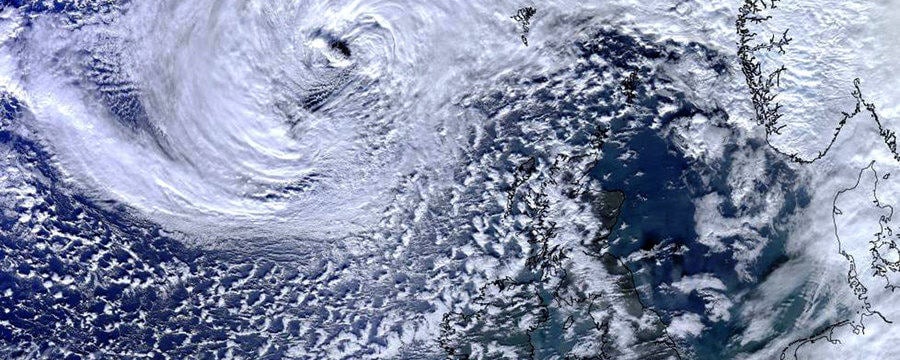Introduction to anticyclones
So far, we have been looking at low pressure systems; cyclones. But what about high pressure systems; anticyclones? From a weather perspective anticyclones can be quite boring.
Where the air pressure is high at the surface in an anticyclone, the air above it descends. As the air descends, the pressure rises (because there is more atmosphere above) and so the temperature of the descending air rises. In this case, evaporation usually exceeds condensation and so cloud droplets don’t form. The air is mostly clear with only small amounts of cloud cover.
In the Northern Hemisphere winds blow in a clockwise direction around an anticyclone. As isobars are normally widely spaced around an anticyclone, winds are often quite light.
Figure 1: The weather map corresponding to Figure 2, showing the location of the anticyclone © Crown Copyright, Met Office.
Figure 2: A satellite image showing clear skies associated with an anticyclone ©NEODAAS/University of Dundee
Figure 3: A schematic diagram showing how the wind fields around a large anticyclone and small depression interact
Figure 4: A typical synoptic chart or weather map from July 2013 © Crown Copyright, Met Office.
Figure 5: A typical satellite image from July 2013 ©NEODAAS/University of Dundee
Figure 6: A typical synoptic chart or weather map from March 2013 © Crown Copyright, Met Office.
Figure 7: Sheep in a field near Pwllglas. ©Creative Commons 2.0. Photo taken by Eirian Evans
Let’s summarise. Anticyclones:
- are larger than low pressure systems
- last longer than low pressure systems
- have lighter winds blowing around them
- have clockwise winds blowing around them in the Northern Hemisphere
- usually give us clear skies
- can give us ‘Anticyclonic gloom’ in spring
Share this
Come Rain or Shine: Understanding the Weather

Come Rain or Shine: Understanding the Weather


Reach your personal and professional goals
Unlock access to hundreds of expert online courses and degrees from top universities and educators to gain accredited qualifications and professional CV-building certificates.
Join over 18 million learners to launch, switch or build upon your career, all at your own pace, across a wide range of topic areas.
Register to receive updates
-
Create an account to receive our newsletter, course recommendations and promotions.
Register for free







